In a previous post I described cutting a piece of red flash gel, and sticking it to the back of my fisheye lens to use as an IR filter. I mentioned that the optical quality of the flash gel probably wasn't as good as a Wratten gelatine filter.
Wratten gelatine filters
Since then, I did buy some Wratten gelatine filters on eBay, but unfortunately they were all mouldy. I bought another lot of Wratten gelatine filters, and these seemed to be okay, except for a piece of dust on one that seemed to have become integrated with the gelatine.
The second lot of filters I bought didn't contain any red filters though, I bought it because it contained a couple of ND filters.
Reading the instructions for the gelatine filters (and also reading user experiences on the web), you need to handle them very carefully. The oil from your skin can easily leave a smear on them, and they are difficult (maybe impossible?) to clean.
Looking on the web, it seems nowhere sells gelatine filters except old ones available on eBay. Eventually, I found that Lee produce a set of polyester filters, which are meant to be similar to gelatine filters. (In that they are thin and you can cut them to size).
Lee polyester filter and making a filter mount
So I purchased a Lee Infrared polyester filter. Really I wanted the Lee Tricolour Red Filter, but I thought it would be better to get the true infrared filter first so I could compare the optical quality against my Hitech CR-39 resin IR filter.
I bought the filter from Warehouse Express, it was about £20 including postage. Cheaper than a Wratten 87 IR filter for £40 off ebay.

To mount the filter on the lens, I cut a circle of cardboard out to act as a mount. At first I used white card, then I realised black would be better to minimise any reflections.
With that done, I trimmed the circle down a couple of times until it fitted nicely on the rear of the lens. I left a tab area untrimmed to give an area to grab the filter from for removing from the lens. Then I cut out the centre of the circle, making sure the hole was big enough.
Next I placed the Lee IR polyester filter between two sheets of paper. I placed the card mount I'd made on top of the paper, then cut around it (not particularly carefully). I used double sided sticky tape to attach the polyester filter to the card mount, and then trimmed the polyester filter to fit the mount better.
I am still using double sided sticky tape on the lens to attach the filter to the lens rear. It seems to be working okay so far.
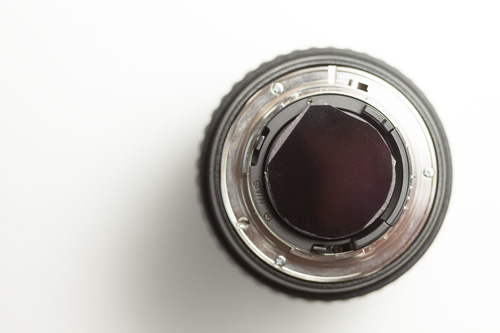
I'm not sure if there is any actual advantage of making a card mount like this, instead of just cutting a piece of polyester filter and attaching it directly. But it seemed like a good idea at the time.
I also made a little cardboard packet to keep the filter in. This should stop it getting bent, scratched, and dirty. I did notice that the filter seems to attract dust very easily, like most filters.

Filter tests
We've not had very much sun, but on Sunday we did get some periods of sun amidst the clouds, so I managed to take a few test shots. I compared the Lee Infrared Polyester filter (rear mounted), The Hitech Infrared CR-39 resin filter (front mounted on Cokin P filter holder), and the Lee 182 Light Red lighting filter (rear mounted).
All the shots were done on my Tokina 10-17mm/3.5-4.5 fisheye zoom lens, at 17 mm. When I first did some tests, I set the lens to focus between 0.4 m and infinity (nearer the 0.4 m mark than the infinity mark). However, I then found that the images were mostly out of focus.
So I took some more shots later in the day, and this time used 4 focus settings for each shot. The focusing scale on the lens is very short between 0.4 m and infinity, so the focus wouldn't be exactly the same for each test, but around the same.
On the computer I checked the shots for the largest depth of field. For all of them I found the ones where focus was set on the right half of the infinity symbol were best. (This is the same as I found for visible light use of the lens with my 5D2).
I used an aperture of f/7.1 and adjusted the shutter speed to try and get a similarly exposed shot for each filter. This was quite difficult as most of the image just looked white on the LCD. When converting the RAW files I used exposure compensation to try and get the images better matching.
Test image 1
I only did two test shots. These are the first one:
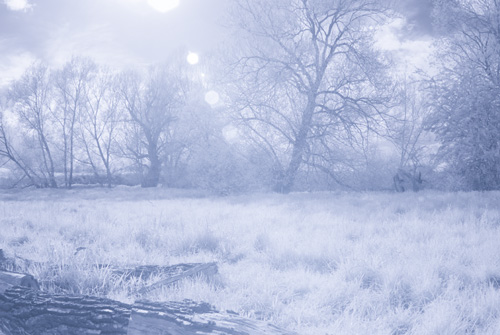
_DIR0503.RAF Lee IR poly ISO100 f/7.1 1/30s +0EV in ACR
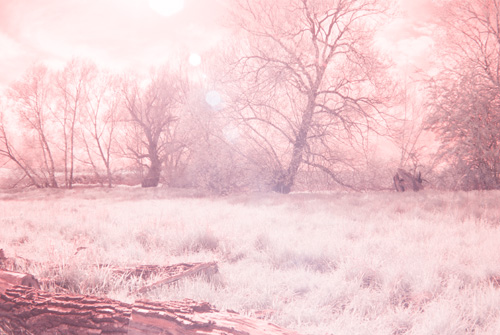
_DIR0507.RAF Lee 182 flash gel ISO100 f/7.1 1/60s -0.55EV in ACR
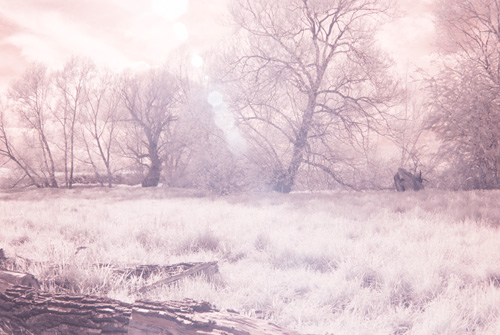
_DIR0511.RAF Hitech IR resin ISO100 f/7.1 1/40s -1.05EV in ACR
You can download the RAF files to compare the images and make your own conclusions if you want. My analysis is below.
As you can see, the Lee infrared polyester filter gives a very different colour to the Hitech filter and the flash gel. The Lee filter is rated to transmit light with a wavelength of 730 nm and greater, while the Hitech filter is meant to start at 720 nm. I wouldn't have thought 10 nm would make such a big difference.
Possibly the Hitech filter actually starts at a shorter wavelength like 700 nm, or the Lee filter starts at a longer wavelength like 780 nm. Or maybe there is some other difference.
To compare the optical quality of the filters, I converted the images to grayscale.
The contrast of the Lee polyester filter seems to be quite a bit less than the other two filters.
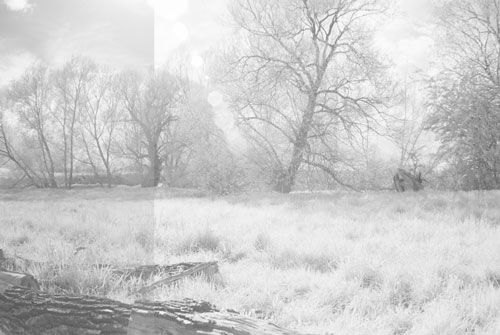
Left Lee polyester, Centre Hitech resin, Right Lee flash gel
So I applied tone curves (in differing strengths) to each image to increase the contrast. Then I compared the images for sharpness.
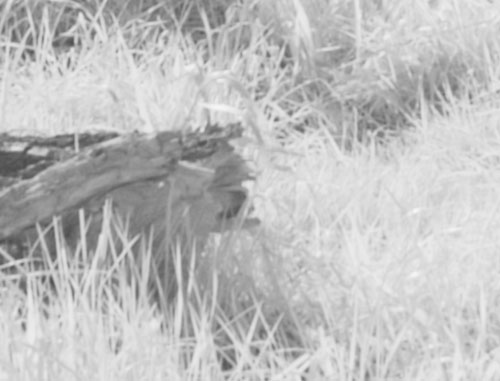
Lee infrared polyester filter
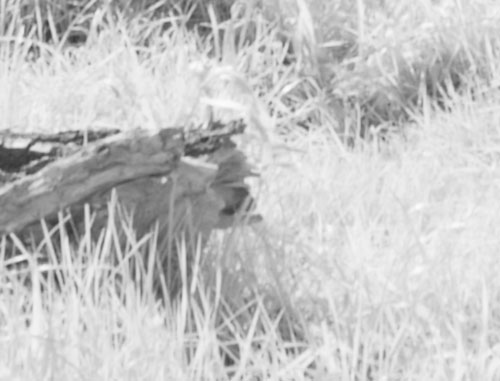
Lee 182 Light Red lighting filter
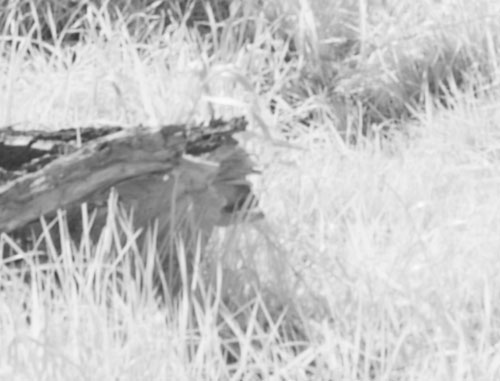
Hitech infrared resin filter

Lee infrared polyester filter

Lee 182 Light Red lighting filter

Hitech infrared resin filter
Despite applying tone curves to adjust the contrast as best I could, you can see the Lee polyester still has less contrast in the centre crop. However, it is important not to mistake contrast for detail, I would say the Lee polyester and Hitech resin are about equal there for detail, with the flash gel very nearly as good.
But in the background, I would say the Lee polyester is slightly better than the Hitech, and both are better than the flash gel. I don't think this is a focus issue as the log in the foreground also looks better in the Lee polyester image to me.
With regards to lens flare circles, I would say the rear mounted filters are equal, while the front mounted Hitech resin filter is slightly worse in this image. In some of the earlier test images I took there seemed to be no difference though. The lack of contrast in the polyester filter image could be due to veiling flare.
Test image 2
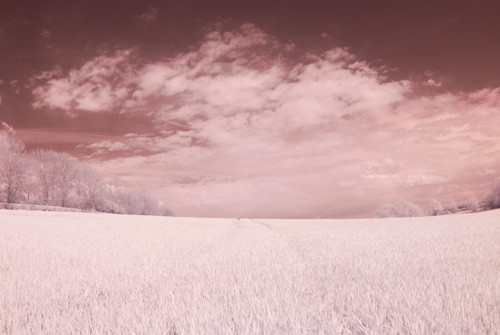
_DIR0518.RAF Hitech IR resin ISO100 f/7.1 1/30s -2EV in ACR
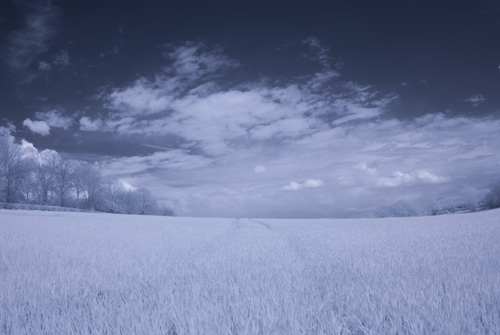
_DIR0523.RAF Lee IR poly ISO100 f/7.1 1/15s -2EV in ACR
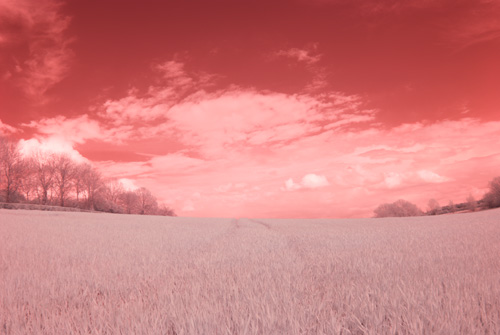
_DIR0527.RAF Lee 182 flash gel ISO100 f/7.1 1/30s -2EV in ACR
For these images, the sun was out for the first shot with the resin filter, then went behind a cloud for the other two images.
Again, I converted all to grayscale and used separate tone curves for each image to increase the contrast.

Hitech infrared resin filter

Lee infrared polyester filter

Lee 182 Light Red lighting filter

Hitech infrared resin filter

Lee infrared polyester filter

Lee 182 Light Red lighting filter
To me the results look the same as from the first test image, all filters are about equal around the center, while the flash gel is worse in the distance.
Channel swap
Here are the three images from test 2 with white balance set on the field, then the blue and red channels swapped in PS using the channel mixer:

Hitech infrared resin filter

Lee infrared polyester filter

Lee 182 Light Red lighting filter
Judging by the lack of colour in the Lee polyester filter image, I think it can be argued that the cut-off of the filter probably starts quite a bit higher than 730 nm.
Conclusion
I think we can say that the Lee polyester filter is comparable in quality to the Hitech resin filter, with the advantage that it can be mounted on the rear of a lens. Regarding the flash gel, it does not appear to offer as good resolution, but it is difficult to tell whether this is due to the filter, or because it lets through more visible light.

Leave a Reply